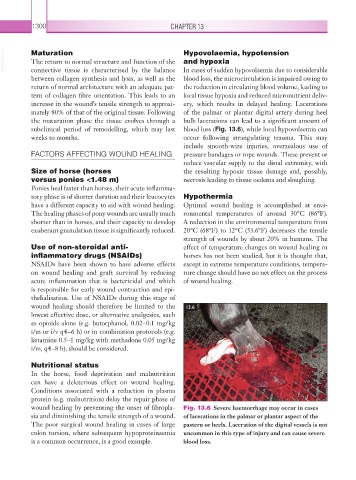Page 1325 - Equine Clinical Medicine, Surgery and Reproduction, 2nd Edition
P. 1325
1300 CHAPTER 13
VetBooks.ir Maturation Hypovolaemia, hypotension
The return to normal structure and function of the and hypoxia
connective tissue is characterised by the balance
blood loss, the microcirculation is impaired owing to
between collagen synthesis and lysis, as well as the In cases of sudden hypovolaemia due to considerable
return of normal architecture with an adequate pat- the reduction in circulating blood volume, leading to
tern of collagen fibre orientation. This leads to an local tissue hypoxia and reduced micronutrient deliv-
increase in the wound’s tensile strength to approxi- ery, which results in delayed healing. Lacerations
mately 80% of that of the original tissue. Following of the palmar or plantar digital artery during heel
the maturation phase the tissue evolves through a bulb lacerations can lead to a significant amount of
subclinical period of remodelling, which may last blood loss (Fig. 13.6), while local hypovolaemia can
weeks to months. occur following strangulating trauma. This may
include smooth-wire injuries, overzealous use of
FACTORS AFFECTING WOUND HEALING pressure bandages or rope wounds. These prevent or
reduce vascular supply to the distal extremity, with
Size of horse (horses the resulting hypoxic tissue damage and, possibly,
versus ponies <1.48 m) necrosis leading to tissue oedema and sloughing.
Ponies heal faster than horses, their acute inflamma-
tory phase is of shorter duration and their leucocytes Hypothermia
have a different capacity to aid with wound healing. Optimal wound healing is accomplished at envi-
The healing phases of pony wounds are usually much ronmental temperatures of around 30°C (86°F).
shorter than in horses, and their capacity to develop A reduction in the environmental temperature from
exuberant granulation tissue is significantly reduced. 20°C (68°F) to 12°C (53.6°F) decreases the tensile
strength of wounds by about 20% in humans. The
Use of non-steroidal anti- effect of temperature changes on wound healing in
inflammatory drugs (NSAIDs) horses has not been studied, but it is thought that,
NSAIDs have been shown to have adverse effects except in extreme temperature conditions, tempera-
on wound healing and graft survival by reducing ture change should have no net effect on the process
acute inflammation that is bactericidal and which of wound healing.
is responsible for early wound contraction and epi-
thelialisation. Use of NSAIDs during this stage of
wound healing should therefore be limited to the 13.6
lowest effective dose, or alternative analgesics, such
as opioids alone (e.g. butorphanol, 0.02–0.1 mg/kg
i/m or i/v q4–6 h) or in combination protocols (e.g.
ketamine 0.5–1 mg/kg with methadone 0.05 mg/kg
i/m, q4–8 h), should be considered.
Nutritional status
In the horse, food deprivation and malnutrition
can have a deleterious effect on wound healing.
Conditions associated with a reduction in plasma
protein (e.g. malnutrition) delay the repair phase of
wound healing by preventing the onset of fibropla- Fig. 13.6 Severe haemorrhage may occur in cases
sia and diminishing the tensile strength of a wound. of lacerations in the palmar or plantar aspect of the
The poor surgical wound healing in cases of large pastern or heels. Laceration of the digital vessels is not
colon torsion, where subsequent hypoproteinaemia uncommon in this type of injury and can cause severe
is a common occurrence, is a good example. blood loss.

